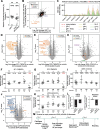Untargeted proteomics enables ultra-rapid variant prioritisation in mitochondrial and other rare diseases
- PMID: 40400026
- PMCID: PMC12096736
- DOI: 10.1186/s13073-025-01467-z
Untargeted proteomics enables ultra-rapid variant prioritisation in mitochondrial and other rare diseases
Abstract
Background: Only half of individuals with suspected rare diseases receive a genetic diagnosis following genomic testing. A genetic diagnosis allows access to appropriate care, restores reproductive confidence and reduces the number of potentially unnecessary interventions. A major barrier is the lack of disease agnostic functional tests suitable for implementation in routine diagnostics that can provide evidence supporting pathogenicity of novel variants, especially those refractory to RNA sequencing.
Methods: Focusing on mitochondrial disease, we describe an untargeted mass-spectrometry based proteomics pipeline that can quantify proteins encoded by > 50% of Mendelian disease genes and > 80% of known mitochondrial disease genes in clinically relevant sample types, including peripheral blood mononuclear cells (PBMCs). In total we profiled > 90 individuals including undiagnosed individuals suspected of mitochondrial disease and a supporting cohort of disease controls harbouring pathogenic variants in nuclear and mitochondrial genes. Proteomics data were benchmarked against pathology accredited respiratory chain enzymology to assess the performance of proteomics as a functional test. Proteomics testing was subsequently applied to individuals with suspected mitochondrial disease, including a critically ill infant with a view toward rapid interpretation of variants identified in ultra-rapid genome sequencing.
Results: Proteomics testing provided evidence to support variant pathogenicity in 83% of individuals in a cohort with confirmed mitochondrial disease, outperforming clinical respiratory chain enzymology. Freely available bioinformatic tools and criteria developed for this study ( https://rdms.app/ ) allow mitochondrial dysfunction to be identified in proteomics data with high confidence. Application of proteomics to undiagnosed individuals led to 6 additional diagnoses, including a mitochondrial phenocopy disorder, highlighting the disease agnostic nature of proteomics. Use of PBMCs as a sample type allowed rapid return of proteomics data supporting pathogenicity of novel variants identified through ultra-rapid genome sequencing in as little as 54 h.
Conclusions: This study provides a framework to support the integration of a single untargeted proteomics test into routine diagnostic practice for the diagnosis of mitochondrial and potentially other rare genetic disorders in clinically actionable timelines, offering a paradigm shift for the functional validation of genetic variants.
Keywords: Genetic diagnostics; Mendelian disease; Proteomics; Ultra-rapid genome sequencing; Variant prioritisation.
© 2025. The Author(s).
Conflict of interest statement
Declarations. Ethics approval and consent to participate: This study was conducted in accordance with the revised Declaration of Helsinki and following the Australian National Health and Medical Research Council statement of ethical conduct in research involving humans. Samples were obtained after receiving written, informed consent for diagnostic or research investigations and publication from the respective responsible human ethics institutional review boards. HREC/RCH/34228, HREC/RCH/34183, HREC/89419/RCHM-2022 and HREC/82160/RCHM-2022 were approved by the Royal Children’s Hospital, Melbourne, Ethics in Human Research Committee. HREC/16/MH/251 was approved by the Melbourne Hospital Ethics in Human Research Committee. The REC reference 2002/205 by the Newcastle and North Tyneside Local Research Ethics Committee. Protocol 10/CHW/45 renewed with protocol 2019/ETH11736 (July 2019–March 2025) was approved by Sydney Children’s Hospitals Network Human Research Ethics Committee. Consent for publication: Details from most participants have been published previously as noted in Additional file 1: Table S1. Unless specified below, participants were enrolled into one of a range of Institutional Review Board (IRB) approved study protocols listed in the Ethics approval and consent to participate section, including consent for data sharing and publication. Three of the validation cohort (VC) participants have not been published previously, and the parents of two (VC15, VC24) provided written consent for publication and clinical summaries are provided in Additional file 2. VC13 was lost to follow-up and we are unable to include identifiable data thus clinical details are not included for privacy reasons. If these data are needed for valid clinical reasons, such as variant curation, please contact david.thorburn@mcri.edu.au. Competing interests: S.T.C is named inventor of Intellectual Property (IP) related to novel methods to identify splicing variants (WO2020097660A1, WO2020/181333). This IP is owned jointly by The University of Sydney and Sydney Children’s Hospitals Network. S.T.C is Director of Frontier Genomics Pty Australia which has licensed this IP. S.T.C currently receives no remuneration for this Director role. The remaining authors declare that they have no competing interests.
Figures




Comment in
-
The case for including proteomics in routine diagnostic practice for rare disease.Genome Med. 2025 May 26;17(1):61. doi: 10.1186/s13073-025-01491-z. Genome Med. 2025. PMID: 40420250 Free PMC article.
References
-
- Haack TB, Haberberger B, Frisch EM, Wieland T, Iuso A, Gorza M, et al. Molecular diagnosis in mitochondrial complex I deficiency using exome sequencing. J Med Genet. 2012;49(4):277–83. - PubMed
-
- Ohtake A, Murayama K, Mori M, Harashima H, Yamazaki T, Tamaru S, et al. Diagnosis and molecular basis of mitochondrial respiratory chain disorders: exome sequencing for disease gene identification. Biochim Biophys Acta. 2014;1840(4):1355–9. - PubMed
MeSH terms
Grants and funding
- PR170396/U.S. Department of Defense
- 1140906/National Health and Medical Research Council
- 2016030/Medical Research Future Fund
- GHFM76747/Medical Research Future Fund
- MR/W019027/1/MRC_/Medical Research Council/United Kingdom
- 1164479/National Health and Medical Research Council
- 203105/Z/16/Z/Wellcome Trust Centre for Mitochondrial Research
- 2010149/National Health and Medical Research Council
- WT_/Wellcome Trust/United Kingdom
- 2010939/National Health and Medical Research Council
- 1377/Royal Children's Hospital Foundation
- G0800674/Mitochondrial Disease Patient Cohort
LinkOut - more resources
Full Text Sources
Medical

